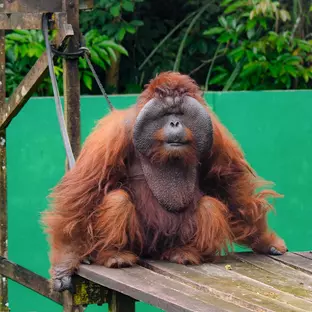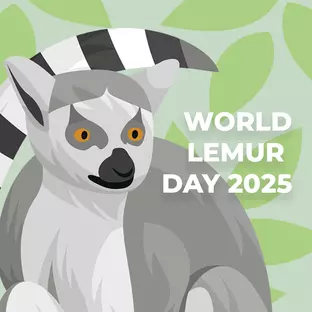Remember the famously heart-wrenching video shared by National Geographic a couple of years ago? Back in December 2017, the world was left shocked and upset by footage of a starving polar bear desperately seeking food on iceless land. Upsetting as the video is, it's impossible to ignore the anguish of the bear, and it is evident that the skeletal animal's struggles are borne from the issue of global warming.
The 27th of February is International Polar Bear Day, and every year the non-profit organisation Polar Bears International (PBI) aims to raise awareness of the plight of this most threatened species. For the past 25 years, conservationists, scientists, and volunteers all associated with PBI have worked hard to serve as a catalyst for change, educating the general public through media, science, and advocacy. Fundamentally, the organisation aims to draw parallels between the remote, icy make-up of the Arctic and the global climate overall – the better our own understanding and the stronger our connection to the polar bear and its home, the more likely the masses will be to act. In tandem with the devastating footage shared previously by National Geographic, Polar Bears International have succeeded in capturing the imagination and empathy of the public, and in light of International Polar Bear Day, we aim to assist in raising awareness of the polar bear’s struggle to survive in an ever-changing world.
All About Polar Bears

As one of eight bear species, the polar bear is actually the youngest of all, with scientists believing that they evolved from brown bear ancestors around 200,000 years ago. Their Latin name is Ursus maritimus, which means ‘sea bear’ – quite a fitting name, given that they’re fantastic swimmers! Indeed, the effects of climate change on their environment can seriously hinder their ability to swim and hunt, as shown in the video at the beginning of this article – a tragic and ironic state of affairs, given how their name sums up their entire existence.
A female bear’s ability to hunt is fundamental to the existence of their family, and the species overall: as well as providing food for their young in the form of prey, the matriarch of the family must be well-fed herself as to produce milk for her cubs to consume. Additionally, the little ones learn everything there is to know from their mothers, studying her actions as she hunts for food beneath the ice and in the water. Without a parent to look up to, baby bears simply would not survive. It is vital that they remain by their mother’s side (typically for 2-and-a-half years after birth); without a role model and provider, cubs are seldom able to survive in the harsh environment of the Arctic. By the time they reach the age of five or six, the young bears may be able to fend for themselves – but starvation poses an ever-increasing risk.
You can learn more about polar bears by clicking here.
Polar Bears In A Warming World

Arguably the most iconic symbol of the Arctic, the polar bear inadvertently illustrates the dangers of global warming, its struggle appearing stark and alarming to the rest of us around the globe. While the bears are perfectly adapted to live in a freezing climate (temperatures in the Arctic can plunge to a staggering -16 degrees Celsius), studies have shown that the climate as of late has risen by over 20 degrees Celsius – disastrous news for the bears and their sea-ice surroundings.
It is the rising of temperatures and an increase of greenhouse gases which impact the polar bear the most. With around 25,000 polar bears left, we simply cannot afford for their habitat to melt away as a result of a warming world – not only would the loss of the bears be an absolute tragedy, but should they vanish from the ecosystem, the world’s marine environment would be thrown out of balance. But even before we’ll see an impact on our oceans, the bears themselves will be subject to suffering in an array of horrific ways, from drowning to starvation to cannibalism. This level of trauma is unthinkable, but according to scientists, there are changes that we can make to prevent such an outcome.
Looking Towards The Future

In addition to providing a wealth of knowledge by way of teaching materials and access to scientific reports, PBI aim to provide a sense of care and compassion to those who have taken an interest in polar bears. PBI offer a tracking tool on their website, where users can watch polar bears as they travel along the sea to hunt – a natural part of their behaviour, but something which must not be forgotten or hindered. For those who are so inclined, there is the opportunity to sponsor a polar bear, and the website also links through to pages outlining other ways to help, some of which we have listed below:
LIVE CLEAN: Despite considerable damage already done to the environment, research has shown that it is not impossible to reverse the effects of climate change, and by making just a few amendments to your daily life, you can help to protect the threatened polar bear. Consider walking, cycling, or taking public transport (such as trains or buses) wherever possible, consume fewer meat products and/or processed foods, and aim to recycle as efficiently and often as possible.
SOCIETAL CHANGE: There are plenty of ways to aid not only your community, but the world of a whole - after all, change does start at home! Whether backing an environmentally-conscious party member for your constituency or helping your friends and family to embrace small changes such as those mentioned above, it's becoming increasingly easy to spread the word and make a change. Which leads us to our next suggestion...
MAKE YOUR VOICE HEARD: In addition to spreading the word both in person and online, you can stand up for environmental change by signing a petition. Polar Bears International host their own petition and, as the authority on all things polar bear, it's an excellent place to start. No matter where in the world you are, you can sign this petition, signalling to the president of the United States of America that the world is serious about climate change. This is something that has become more important than ever, given the world's politics since November 2016, and it's important that the people of the world continue to push for change.
Above all else, we ask our followers to re-examine their own actions and to fight against the severity of climate change. This video at the beginning of this post is a brutally honest portrayal of the impact global warming has on nature - and indeed, the rest of the world - and we must act now to protect our planet. Move to more energy-efficient providers, select marketplaces which are closer to home (as to reduce the carbon footprint of your purchases), or commit to any of these changes in the hopes of making a difference to the lives of polar bears, providing a safer world for not only them, but for generations to come.
If you wish to raise awareness of polar bear protection, why not consider sharing the infographic below?














